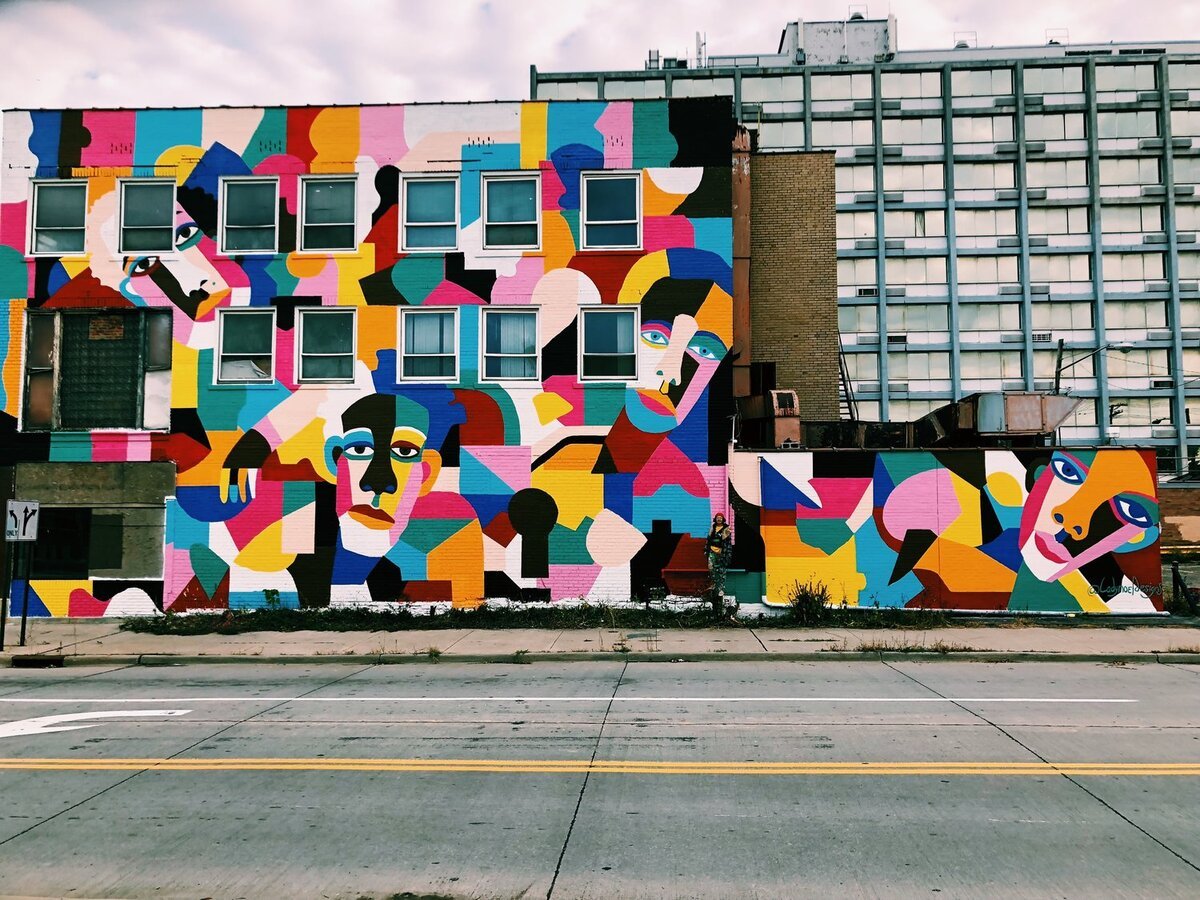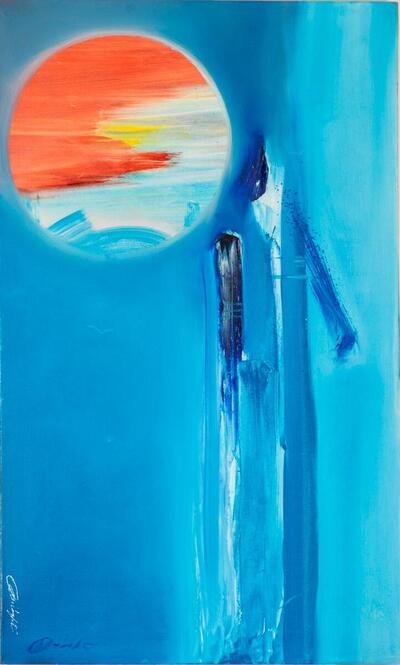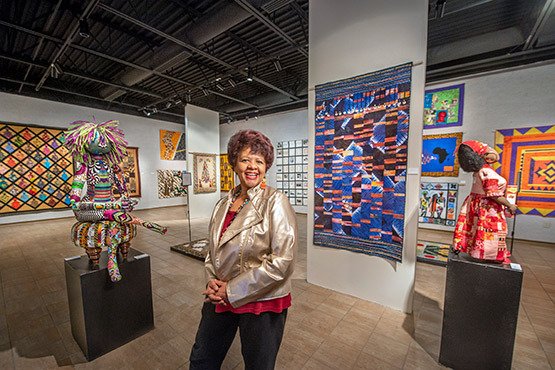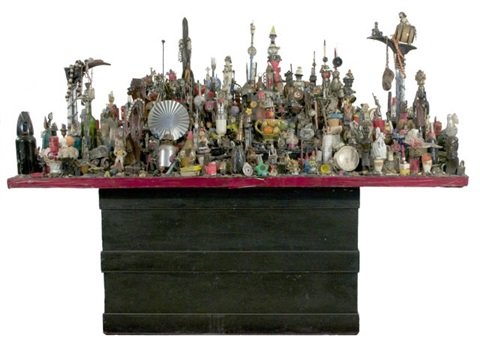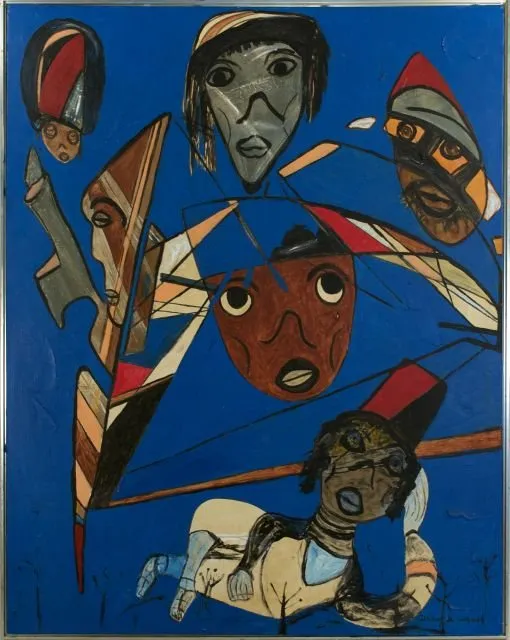8 Black Cleveland Artists You Should Know About
Honoring Black History Month
February is Black History Month – a time to honor and celebrate the impact of Black experiences and achievements in our community.
Every week in February, we will add two local Black artists to this blog, whose contributions to the Cleveland art scene deserve to be recognized year-round.
The first week of Black History Month, we kick off with two artists - Antwoine Washington and the late Moe Brooker. Read on to learn more.
Antwoine Washington
After graduating college, Antwoine Washington moved to Cleveland with his wife, where he started working as a mail carrier for the U.S. Postal Service. In college, Antwoine drew inspiration from the artists of the Harlem Renaissance, names like Elizabeth Catlett and Romare Bearden, who moved him to start telling stories of the Black experience through his art. He worked hard to quit his job with the post office and decided to pursue his dreams of becoming a full-time artist. After suffering a stroke in 2018, Antwoine continued to turn to his art to find deeper meaning and support his recovery. Through color and the art of storytelling, he continues to explore the daily life and emotions of Black Americans and in doing so, finds a thread to a not-so-distant past.
Recent projects of his include a limited-edition design celebrating the 100th Anniversary of the Cuyahoga County Public Library, a mural commissioned by Land Studios in Cleveland Public Square, and the birth of his non-profit, the Museum of Creative Human Art, which encourages young, underserved artists to pursue their creative expression.
Antwoine currently works and lives in Cleveland, OH.
Learn about Antwoine’s story and view more of his work on his website.
Photo Cred. Gary Horn Photography
Moe Brooker
The late Moe Brooker was a native of Philadelphia, PA. He came to Cleveland in 1979 to teach at the Cleveland Institute of Art, where he became that school's first full-time African-American instructor. A bit after arriving in Cleveland, he was awarded top honors at the May Show, a prestigious art show. This was a big win for the black community, breaking the common perception that no black artists could win the show. Moe’s interest in art began during his childhood, drawing comic book figures. He attended the Pennsylvania Academy of Fine Arts and also spent some time studying abroad in Paris and Rome.
He was greatly influenced by the Cleveland jazz and art scene during the 1970s, crediting the city and its arts culture for fostering his development as an artist. He spoke candidly about the relationship between art and race, protesting the label "African-American art" as a "ludicrous and unimportant" distinction. Listen to an interview of him from 2008 to hear it from the man himself, or learn more about him here, and take a look at the piece sold in our February auction here.
Recently sold in our February 2023 auction, Moe Brooker’s Mr. Ebo’s Circus
Lauren Pearce
Lauren Pearce is a Cleveland native and single mother who started her professional career in the arts at the young age of 24. Through her art, she seeks to explore the meaning of identity, race, and womanhood.
Working primarily as a mixed-media artist, Lauren’s contemporary style pushes the boundaries of color, texture, and imagination while often finding movement through the human body. She has completed murals throughout the city of Cleveland, including a recent commission in Playhouse Square and the mural of faces at the intersection of 36th & Euclid Ave. Her work has also been featured in Architectural Digest and art galleries across the globe.
The late Al Bright’s legacy as an artist and educator still shines on throughout Ohio, having influenced many generations of young minds in his time as a teacher at Youngstown State University. As the first full-time African-American faculty member at YSU, Bright founded the school’s Africana Studies program in 1970–one of the first of its kind in the Ohio education system. He was also a three-time recipient of the Distinguished Professorship Award during his time at Youngstown.
Born and raised in the Mahoning Valley, Bright completed his undergraduate degree in Art Education at YSU and went on to receive his Master’s in Painting from Kent State. His artistic career spanned many years and more than 100 solo exhibits.
The world lost this great artist in 2019, but several of his works are still available for viewing in the permanent collections at The Butler Institute of American Art, the Kent State University Gallery, the Canton Museum of Art, and more.
Check out his live painting performances on YouTube and view pieces of Bright’s work from our auction archives below.
Julie Patton
A visual artist, sculptor, poet, and performer, Julie Patton’s career spans a colorful array of mediums and genres. She was born in Cleveland, to the great late artist, Virgie Ezelle Patton. After receiving her B.F.A from Antioch College in 1979, Julie spent time as an educator, teaching at Teachers & Writers Collaborative, Learning Thru Art at the Guggenheim Museum, the Studio In a School Program at New York University and other respected institutions across the globe.
Patton is a multi-award-winning artist, having been awarded a 2007 New York Foundation for the Arts Poetry Fellowship, a 2015 grant from the Foundation of Contemporary Arts, a Doan Brook Association's 2012 Watershed Hero Award among many more. Most recently, she was the 2022 recipient of The Robert P. Bergman Prize, honoring her for a lifetime of work focused on the democratic vision of art.
She is the author of numerous titles including Teething on Type (1996), Using Blue To Get Black (2008), and Writing With Crooked Ink (2015). Her written work has also been featured in several poetry anthologies, including Best American Experimental Writing 2016 (Wesleyan University Press, 2015).
Perhaps one of her most artistic accomplishments is the creation of Let It Bee Ark Hives in Glenville, a living installation for scholars and creatives featuring several of Patton's projects, as well as pieces honoring the legacy of her mother's work.
She now splits her time between Cleveland and New York City.
Dexter Davis
Dexter Davis is a contemporary artist living and working in Cleveland, OH. Davis grew up in Hough during the 1960s and 1970s where he witnessed the violence and suffering that plagued his neighborhood. These childhood experiences would have a great impact on his work as he pursued his dream of becoming an artist.
Shortly after graduating from the Cleveland Institute of Art, he began working as a guard at the Cleveland Museum of Art in the 1990s. In 2011, the museum purchased one of his works, making him the first member of the security team to be featured in the museum. Davis’ work remains on display in the museum’s collection, in addition to the collections of the Cleveland Clinic, and the Progressive Art Collection. In 2000, Davis served as artist-in-residence at Zygote Press. His work has also been exhibited by the Akron Museum of Art, Kent State University, the William Busta Gallery, and the Museum of Contemporary Art in Cleveland.
In 2020, Davis was the victim of a road-rage shooting in University Circle, which left a bullet lodged in his lower back. The experience reignited the painful memories and emotions of his violent childhood. Through a variety of mediums, Davis explores his feelings of grief and loss, using his art as a vehicle to express himself and heal.
Read a feature about Davis and his art published in Cleveland Magazine here.
Anna Arnold
Community muralist and artist Anna Arnold was born and raised in Cleveland, OH. She received her BFA from the Cleveland Institute of Art in 1983 and her Master's in Art Education from Case Western Reserve University in 2010. Affectionately nicknamed the “Queen of Color”, Anna has worked as a painter, sculptor, ceramicist and jewelry artist for nearly 30 years.
She has exhibited in over 200 gallery and museum shows across the U.S., including the and the California African American Museum, the Cleveland Museum of Art, the Chicago Public Library, and the National Black Arts Festival in Atlanta.
In her time as an educator, Anna has taught hundreds of students at several workshops and residencies throughout Ohio. She also worked as the art instructor at the Heights Youth Club and the Boys & Girls Club of Cleveland, as well as the Cleveland Bureau of Cultural Arts Mural My Neighborhood skill-training program for teens.
Reverend Albert Wagner
Born in 1924 in rural Arkansas, Albert Wagner worked as a laborer before moving to Cleveland with his family at the age of 17. Though he left school in the third grade, he recalled fond memories of drawing pictures of airplanes and railroad cars as a child. It wasn’t until his 50th birthday, as he was cleaning out his basement for his party, that he felt the call to pursue his artistic dreams. Inspired by a splattering of paint on an old board, Wagner began his first painting that night and set out on an illustrious 32-year journey as a multidisciplinary artist. His work often drew on religious themes and social matters, frequently featuring stories of his childhood in the American South.
Few artists see their legacy nationally recognized, but Wagner’s legacy has been widely exhibited across the country, with shows at the Akron Museum of Art and the American Visionary Museum of Art in Baltimore. He was also the subject of an Life Magazine exposé "Faith in Paint" in May 1998.
His three-story East Cleveland home previously housed the People Love People House of God Ministry and was decorated with found objects and thousands of Reverend Wagner’s works.
Albert created over 3,000 paintings and sculptures in his home studio, until his death in September 2006 at age 82. The Wagner Museum of Art, a museum dedicated to the late folk artist, plans to open in Cleveland this fall.
“All of these years have passed since I was that little boy on my mother’s back porch, and now I realize that all I wanted to do is paint. I’m not trying to make myself different from anybody, but God made me what I am, and it is important to me to introduce to the black world, my little black sisters and brothers, that you can take an old television, an old stove, anything you want, and make a sculpture of it. Even the bottom of an old dresser drawer, a door or a window. At first, I thought I had nothing to work with, but then I found that everything I wanted was in the street or the alleys. Everything in here is made up of Elmer’s glue, good will, gifts from people and the streets. So now I have a whole museum to show the world.” – Reverend Albert Wagner







